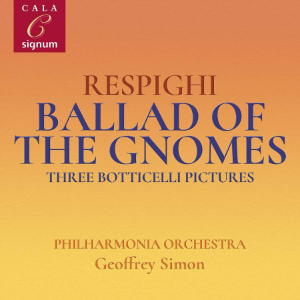
Ottorino Respighi (1879-1936)
Ballad of the Gnomes (1920)
Trittico Botticelliano (1927)
Suite in G for Strings and Organ (1905)
Adagio con variazioni for Cello and Orchestra (1921)
Leslie Pearson (organ)
Alexander Baillie (cello)
Philharmonia Orchestra/Geoffrey Simon
rec. 1990, Goldsmiths College, London
Cala Signum SIGCD2161 [69]
Signum, which presently has exclusive rights to Geoffrey Simon’s old Cala catalogue, revives a collection of appealing, less familiar Respighi. It helps to flesh out our view of a composer too narrowly known, for the “Roman” tone poems, though, despite unexpected echoes and pre-figurings, it sometimes feels like “the same, only different.”
Actually, the set of Three Botticelli Pictures – as the Trittico is sometimes billed in English – teeter on the fringes of the standard repertoire. Several recordings, perhaps influenced by the classic Marriner account (EMI-to-Warner), have used a chamber ensemble, but it’s nice to hear a full-sized orchestra playing it for a change. In the first movement, Simon pivots deftly between the main, jig-like dance theme and a perky, quicker wind chorale. The bassoon solo of The Adoration of the Magi doesn’t quite manage plaintive – it needs more breathing time – but the reeds intone O Come, O Come Emmanuel smoothly, and the mildly dissonant lullaby later on is tender. My note for The Birth of Venus calls it “briskly rocking”; it, like the second, settles in, and the low-octave motifs are suitably imposing.
The title Ballad of the Gnomes suggests a “lollipop” like Grieg’s In the Hall of the Mountain King, but it’s actually a full-scale tone poem, a bit of a trial run for The Pines of Rome a few years later. It has a similarly splashy opening, complete with whooping horns, here secondary rather than thematic; a calm string chorale that opens out aspiringly, with a vibrant solo violin; a disturbed passage that suggests Respighi Mahler; and an urgent, dynamic closing section that eventually loses steam. It’s good, but the Pines are better.
Even without having read the booklet note, I realized the Suite in G was a homage to the Baroque, with the Preludio‘s bustling string activity, angular contours, and motivic sequences. The harmonic idiom is Baroque-with-diatonic-sevenths; the organ, at least as registered here, sounds incongruously liturgical. The Ariabegins forebodingly over a sustained bass, opening into a broad, pulsing passage where the violins sing out passionately, then moves into an oddly Elgarian major. The Pastorale opens with a single-line, minor-key siciliana that feints at a fugue; there’s a lovely meditative organ solo later on. The Cantico sets a powerful full-organ chorale against a more subdued one for the strings.
The Adagio with Variations began life as a cello-and-piano piece, with the composer later being persuaded to orchestrate it. It opens with the cello singing ardently over a dignified walking bass, remaining serene until a gentle, high woodwind chorale introduces more intensity. Optimistic woodwind phrases all too quickly revert to the troubled minor. The score gradually settles into a satisfying, affirmative finish – a high cello flourish along the way suggests The Lark Ascending – though the coda goes on too long.
The Philharmonia plays handsomely. The upper string chords frequently have an airy transparency, though they never quite shimmer. The horns, especially in the Trittico, are firm and focused. The woodwinds are liquid and mostly true – though I’m not so sure of that high woodwind chorale I mentioned in the Adagio– but tend to be too loud: in the Trittico, the decibels undercut the restrained demeanour.
The sonics are vivid. The lower brasses register with a nice depth; the organ in the Suite is in, yet not of, the performing space; the first big climax in the Trittico gets firm, full bass support. I remember much of the original Cala series as beimg conspicuously resonant. The present booklet credits Phil Rowlands with “[r]emastering,” and his work seems to have trimmed the bloat: the acoustic remains warm, but never distracting.
Stephen Francis Vasta
stevedisque.wordpress.com/blog
Help us financially by purchasing from




















